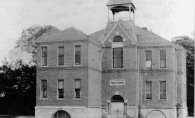Hard-core sailors on Lake Minnetonka couldn’t wait until the warm summer breezes filled their sails. Instead, they took a cue from bundled New York yachtsmen on the Hudson River who built their ice boats beginning in the late 1790s to skate over the frozen ice. These ice yachts were the fastest vehicles of their era and famously zipped past steaming locomotives chugging along the shores of the river.
In the 1890s, some of the first ice yachts cruised the wide expanse of Lake Pepin, and the Pepin Ice Yacht Club of Wisconsin challenged the Lake City Ice Yacht Club. The Minnetonka Ice Yacht Club soon joined the race for the J.B. Hudson Cup, which marked the championship of the ice racing world in the northwest. The Minnetonka club purchased ice yachts from the Hudson River club in New York and added them to its fleet for a total of 35 ice boats. Some of these boats could handle up to eight people who would constantly have to shift their weight to balance the schooner.
In the 1890s, a historic race took place on Lake Minnetonka with the Lake Pepin team challenging Minnetonka. The race began with a crew pushing the boat to get up to speed and then the usually two-person crew hopping aboard. Boats such as the heavy Cyclone from Lake Pepin had already reached 80 miles per hour in races and others such as the Phoebe, a “jack-rabbit” boat, were made very light with silk sails. A couple of newsies from Minneapolis had built the homemade boat named the What-Not. Another was the Nancy run by a young man, George Bassett, and his 17-year-old sister Nan, for whom the boat was named.
During the tie-breaking race, Bassett and Nan pushed the boat from the starting line, but he slipped on the ice and the boat zipped away without him and only his little sister Nan to steer. Even though she’d never handled the boat alone, she controlled the sails and took advantage of her light weight to fly through the course. With gusts nearly tipping the boat, she held on to win the race for Minnetonka. Even the Lake Pepin team congratulated her as the first woman to win an ice yacht race.
Theodore Wetmore, the “father of ice-yachting in the west,” took the title of commodore and helped incorporate the new club by 1899 as part of the Minnetonka Yacht Club on the little Tahtu (Bug) Island in St. Louis Bay near Deephaven. This salty old sailor had the fastest ice yacht on the lake, the North Star, and he zipped back in forth outside of Excelsior one day challenging the only other ice boat that could come close: the Red Dragon. When the yellow-bellied Red Dragon stayed home, Wetmore and his cronies stopped on the ice in front of Excelsior to claim their win by forfeit. As they stood on the ice, the commodore forgot to anchor his ice yacht and a gust of wind filled the sails. The North Star skated away and crashed into a nearby pavilion, reducing the boat to kindling.
While the original building for the Minnetonka Ice Yacht Club burned to the ground just a few years after its construction, ice boating continued on Lake Minnetonka during the winter months. When asked if this sport is safe, the Minnesota Ice Sailing Association wrote, “Nope, not a chance. Iceboating is an inherently dangerous sport; anybody suggesting it's safe is lying. In fact if you do it long enough, it's sure to either kill, cripple or maim you.”









